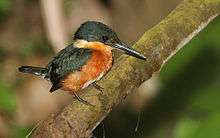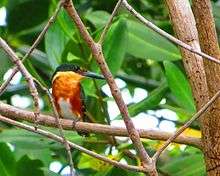American pygmy kingfisher
The American pygmy kingfisher (Chloroceryle aenea) is a resident breeding kingfisher which occurs in the American tropics from southern Mexico south through Central America to western Ecuador, and then around the northern Andes cordillera in the east to central Bolivia and central Brazil. The species occupies the entire Amazon basin and the Tocantins River drainage adjacent in Pará state Brazil. It also occurs on Trinidad.
| American pygmy kingfisher | |
|---|---|
 | |
| Male | |
| Scientific classification | |
| Kingdom: | Animalia |
| Phylum: | Chordata |
| Class: | Aves |
| Order: | Coraciiformes |
| Family: | Alcedinidae |
| Subfamily: | Cerylinae |
| Genus: | Chloroceryle |
| Species: | C. aenea |
| Binomial name | |
| Chloroceryle aenea (Pallas, 1764) | |
| Synonyms | |
| |
Taxonomy
The first formal description of the American pygmy kingfisher was by the German zoologist Peter Simon Pallas in 1764 under the binomial name Alcedo aenea.[2][3] The specific name aenea is from the Latin aeneus meaning "of a bronze colour".[4] The current genus Chloroceryle was erected by Johann Jakob Kaup in 1848.[5]
A molecular phylogenetic study published in 2006 found that the American pygmy kingfisher was a sister species to a clade containing the green-and-rufous kingfisher (C. inda) and the green kingfisher (C. americana).[6]
Two subspecies are currently recognized:[7]
Description

The American pygmy kingfisher is 13 cm (5.1 in) long and weighs 10–16 g (0.35–0.56 oz). It has the typical kingfisher shape, with a short tail and long bill. It is oily green above, with a yellow-orange collar around the neck, rufous underparts and a white belly. The female has a narrow green breast band. Young birds resemble the adults, but have paler rufous underparts, no breast band, and speckled wings and flanks. The nominate southern C. a. aenea has two lines of white spots on the wings, while the northern C. a. stictoptera has three or four lines of spots and a concealed white patch of feathers on the undertail. The two forms intergrade in central Costa Rica.[8]
The call is a gives a weak tik or stony cht cht.[8]
Distribution and habitat
This tiny kingfisher occurs in dense forests and mangrove swamps along small streams or rivers with heavily vegetated banks. The unlined nest is in a horizontal tunnel up to 40 cm (16 in) long made in a river bank, earth heap, or occasionally an arboreal termite nest.[8] The female lays three, sometimes four, white eggs.[9][10]
American pygmy kingfishers perch quietly on a low branch close to water before plunging in head first after small fish or tadpoles. They will also hawk for insects. They are not shy, but easily overlooked as they sit silently amongst riverside branches.[8]
References
- BirdLife International (2012). "Chloroceryle aenea". IUCN Red List of Threatened Species. 2012. Retrieved 26 November 2013.CS1 maint: ref=harv (link)
- Peters, James Lee, ed. (1945). Check-list of Birds of the World. Volume 5. Cambridge, Massachusetts: Harvard University Press. p. 170.
- Sherborn, C. Davies (1905). "The new species of birds in Vroeg's catalogue, 1764". Smithsonian Miscellaneous Collections. 47: 332–341 [333 No 54].
- Jobling, James A. (2010). The Helm Dictionary of Scientific Bird Names. London: Christopher Helm. p. 33. ISBN 978-1-4081-2501-4.
- Kaup, Johann Jakob (1848). "Die Familie der Eisvögel (Alcedidae)". Verhandlungen des Naturhistorischen Vereins für das Großherzogthum Hessen und Umgebung (in German). 2: 68. OCLC 183221382.
- Moyle, Robert G (2006). "A molecular phylogeny of kingfishers (Alcedinidae) with insights into early biogeographic history" (PDF). Auk. 123 (2): 487–499. doi:10.1642/0004-8038(2006)123[487:AMPOKA]2.0.CO;2. hdl:1808/16596.
- Gill, Frank; Donsker, David, eds. (2017). "Rollers, ground rollers & kingfishers". World Bird List Version 7.2. International Ornithologists' Union. Retrieved 28 May 2017.
- Fry, Fry & Harris 1992, pp. 224-225.
- Woodall, P.F. (2017). del Hoyo, J.; Elliott, A.; Sargatal, J.; Christie, D.A.; de Juana, E. (eds.). "American Pygmy-kingfisher (Chloroceryle aenea)". Handbook of the Birds of the World Alive. Lynx Edicions. Retrieved 25 May 2017.
- Fry, Fry & Harris 1992, p. 6.
Sources
- ffrench, Richard (1991). A Guide to the Birds of Trinidad and Tobago (2nd ed.). Boston: Comstock Publishing. ISBN 0-8014-9792-2.
- Fry, C. Hilary; Fry, Kathie; Harris, Alan (1992). Kingfishers, Bee-eaters, and Rollers. London: Christopher Helm. ISBN 978-0-7136-8028-7.CS1 maint: ref=harv (link)
- Hilty, Steven L (2003). Birds of Venezuela. London: Christopher Helm. ISBN 0-7136-6418-5.
- Stiles, F. Gary; Skutch, Alexander F. (1990). A Guide to the Birds of Costa Rica. Ithaca, N.Y: Comstock Publishing. ISBN 0-8014-9600-4.
External links
| Wikimedia Commons has media related to Chloroceryle aenea. |
| Wikispecies has information related to Chloroceryle aenea |
- Xeno-canto: audio recordings of the American pygmy kingfisher
- American pygmy kingfisher videos, photos & sounds on the Internet Bird Collection
- Stamps (for El Salvador) with RangeMap
- American pygmy kingfisher photo gallery VIREO Photo-High Res
